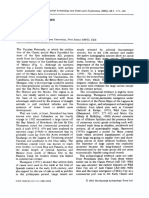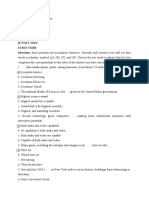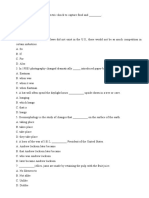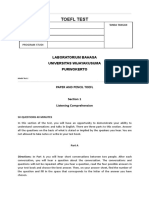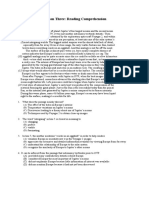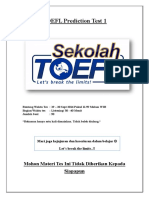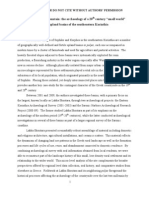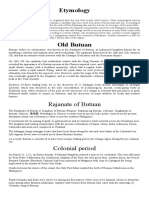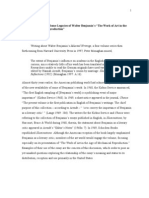Read TOEFL For Students Dec 15
Read TOEFL For Students Dec 15
Uploaded by
Robhy AlfarobiCopyright:
Available Formats
Read TOEFL For Students Dec 15
Read TOEFL For Students Dec 15
Uploaded by
Robhy AlfarobiOriginal Description:
Original Title
Copyright
Available Formats
Share this document
Did you find this document useful?
Is this content inappropriate?
Copyright:
Available Formats
Read TOEFL For Students Dec 15
Read TOEFL For Students Dec 15
Uploaded by
Robhy AlfarobiCopyright:
Available Formats
Questions 1-10
line
(5)
(10)
(15)
(20)
The final battle of the War of 1812 was the battle of New Orleans. This battle gave a clear
demonstration of the need for effective communication during wartime. It also showed the disastrous
results that can come to pass when communication is inadequate.
The war of 1812 was fought between Great Britain and the very young country of the United
States only a relatively few years after the United States had won its independence from Britain. The
United States had declared war against Britain in June of 1812, mostly because of interference with
U.S. shipping by the British and because of the shanghaiing of U.S. sailors for enforced service on
British vessels. The war lasted for a little more than two years, when a peace treaty was signed at
Ghent, in Belgium, on the 24th of December, 1814.
Unfortunately, the news that Treaty of Ghent has been signed and that the war was officially over
was not communicated in a timely manner over the wide distance to where the war was being
contested. Negotiations for the treaty and the actual signing of the treaty took place in Europe, and
news of the treaty had to be carried across the Atlantic to the war front by ship. A totally unnecessary
loss of life was incurred as a result of the amount of time that it took to inform the combatants of the
treaty.
Early in January of 1815, some two weeks after the peace treaty had been signed, British troops
in the southern part of the United States were unaware that the war had officially ended. Over 5,000
British troops attacked U.S. troops. During the ensuing battle, known as the Battle of New Orleans,
the British suffered a huge number of casualties, around 2,000, and the Americans lost 71, all in a
battle fought only because news of the peace treaty that had already been signed in Ghent had not yet
reached the battlefield.
1. The main idea of this passage is that
(A)
the war of independence was
unnecessary
(B) the war of 1812 was unnecessary
(C) the Treaty of Ghent was unnecessary
(D) The Battle of New Orleans was
unnecessary
4. According to the passage, when did the
United States win its independence from
Britain?
(A) Shortly before the War of 1812
(B) During the War of 1812
(C) Just after the War of 1812
(D) Long after the War of 1812
2. The pronoun it in line 2 refers to
(A) battle
(B) demonstration
(C) communication
(D) wartime
3. The expression come to pass in line 3
could best be replaced by
(A) happen
(B) overthrow
(C) self-destruct
(D) circumvent
5. According to the passage, some U.S. sailors
were
(A) taken forcibly to Shanghai
(B) made to go to Ghent
(C) forced to work on British ships
(D) responsible for causing the War of
1812
6. It is NOT stated in the passage that Ghent
was
(A) where negotiation took place
(B) the site of the final battle
(C) where the treaty was signed
(D) far from the battlefield
7. The word contested in line 12 is closest in
meaning to
(A)
(B)
(C)
(D)
played
fought
discussed
examined
8. It can be determined from the passage that,
of the following dates, the Battle of New
Orleans was most probably fought
(A) on December 10, 1814
(B) on December 24, 1814
(C) on January 1, 1815
(D) on January 8, 1815
9. Where is the passage does the author
indicate when the war of 1812 officially
ended?
(A) Lines 1-3
(B) Lines 4-5
(C) Lines 8-9
(D) Lines 10-12
10. Which paragraph describes the battle that
took place after the signing of the treaty?
(A)
(B)
(C)
(D)
The first paragraph
The second paragraph
The third paragraph
The last paragraph
Questions 11-21
line
(5)
(10)
(15)
(20)
In the American colonies there was little money. England did not supply the colonies with coins
and it did not allow the colonies to make their own coins, except for the Massachusetts Bay Colony,
which received permission for a short period in 1652 to make several kinds of silver coins. England
wanted to keep money out of America as a means of controlling trade; America was forced to trade
only with England if it did not have the money to buy products from other countries. The result during
this pre-Revolutionary period was that the colonists used various goods in place of money: beaver
pelts, Indian wampum, and tobacco leaves were all commonly used substitutes for money. The
colonists also made use of any foreign coins they could obtain. Dutch, Spanish, French, and English
coins were all in use in the American colonies.
During the Revolutionary War, funds were needed to finance the war, so each of the individual
states and the Continental Congress issued paper money. So much of this paper money was printed
that by the end of the war, almost no one would accept it. As a result trade in goods and the use of
foreign coins still flourished during this period.
By the time the Revolutionary War had been won by the American colonists, the monetary
system was in a state of total disarray. To remedy this situation, the new Constitution of the United
States, approved in 1789, allowed Congress to issue money. The individual states could no longer have
their own money supply. A few years later, the Coinage Act of 1792 made the dollar the official
currency of the United States and put the country on a bimetallic standard. In this bimetallic system,
both gold and silver were legal money, and the rate of exchange of silver to gold was fixed by the
government at sixteen to one.
11. The passage mainly discusses
(A) American money from past to present
(B) the English monetary policies in
colonial America
(C) the American monetary system of the
seventeenth and eighteenth centuries
(D) the effect of the Revolution on
American money
12. The passage indicates that during the
colonial period, money was
(A)
(B)
(C)
(D)
supplied by England
scarce
coined by the colonists
used extensively for trade
13. The Massachusetts Bay Colony was
allowed to make coins
(D)
from 1652 until the Revolutionary
War
14. The expression a means of in line 4 could
best be replaced by
(A)
(B)
(C)
(D)
a method for
an example of
a result of
a punishment for
15. Which of the following is NOT mentioned
in the passage as a substitute for money
during the colonial period?
(A)
(B)
(C)
(D)
Cotton
Wampum
Tobacco
Beaver furs
16. The pronoun it in line 12
(A) continuously from the inception of the
colony
(B) throughout the seventeenth century
(C) for a short time during one year
(A)
(B)
(C)
(D)
Paper money
The Continental Congress
The war
Trade in good
17. It is implied in the passage that at the end of
the Revolutionary War, a paper dollar was
worth
(A)
(B)
(C)
(D)
exactly one dollar
just under one dollar
almost nothing
just over one dollar
18. The word remedy in the line 15 is closest
in meaning to
(A)
(B)
(C)
(D)
20. According to the passage, which of the
following is NOT true about the bimetallic
monetary system?
(A) Gold could be exchanged for silver at
a rate of sixteen to one.
(B) Either gold or silver could be used as
official money.
(C) The monetary system was based on
two metals.
(D) It was established in 1792.
medicate
understand
renew
resolve
19. How was the monetary system arranged in
the Constitution?
(A) The dollar was made the official
currency of the United States.
(B) The United States officially went on a
bimetallic monetary system.
(C) Various state governments, including
Massachusetts, could issue money
(D) Only the United States Congress could
issue money.
Question 21-30
line
(5)
(10)
(15)
A rather surprising geographical feature of Antarctica is that a huge freshwater lake, one of the
worlds largest and deepest, lies hidden there under four kilometers of ice. Now known as Lake
Vostok, this huge body of water is located under the ice block that comprises Antarctica. The lake is
able to exist in its unfrozen state beneath this block of ice because its waters are warmed by
geothermal heat from the earths core. The thick glacier above lake Vostok actually insulates it from
the frigid temperatures (the lowest ever recorded on Earth) on the surface.
The lake was first discovered in the 1970s while a research team was conducting an aerial survey
of the area. Radio waves form the survey equipment penetrated the ice and revealed a body of water of
indeterminate size. It was not until much more recently that data collected by satellite made by
scientists aware of the tremendous size of the lake; the satellite-borne radar detected an extremely flat
region where the ice remains level because it is floating on the water of the lake.
The discovery of such a huge freshwater lake trapped under Antarctica is of interest to the
scientific community because of the potential that the lake contains ancient microbes that have
survived for thousands upon thousands of years, unaffected by factors such as nuclear fallout, and
elevated ultraviolet light that have affected organisms in more exposed area. The downside of the
discovery, however, lies in the difficulty of conducting research on the lake in such a harsh climate and
in the problems associated with obtaining uncontaminated samples from the lake without actually
exposing the lake to contamination. Scientists are looking for possible ways to accomplish this.
21. The purpose of the passage is to
(A) explain how lake Vostok was
discovered
(B) provide satellite data concerning
Antarctica
(C) present an unexpected aspect of
Antarcticas geography
(D) discuss future plans for lake Vostok
22. The word lies in line 2 could best be
replaced by
(A)
(B)
(C)
(D)
sits
sleeps
tells falsehoods
inclines
23. What is true of Lake Vostok?
(A)
(B)
(C)
(D)
It is completely frozen.
It is beneath a thick slab of ice
.It is not a saltwater lake.
It is heated by the sun.
27. The word microbes in line 13 could best
be replaced by which of the following
(A) Pieces of dust
(B) Tiny organisms
(C) Trapped bubbles
(D) Ray of light
28. The passage mentions which of the
following as a reason for the importance of
Lake Vostok to scientists?
(A) It may contain uncontaminated
microbes.
(B) It can be studied using radio waves.
(C) It may have elevated levels of
ultraviolet light.
(D) It has already been contaminated.
29. The word downside in line 15 is closest in
meaning to
(A) negative aspect
(B) bottom level
(C) underside
(D) buried section
24. Which of the following is closest in
meaning to frigid in line 6
(A)
(B)
(C)
(D)
Rarely recorded
Never changing
Quite harsh
Extremely cold
25. All of the following are true about the 1970
survey of Antarctica EXCEPT that it
(A)
(B)
(C)
(D)
was conducted by air
made use of radio waves
was controlled by a satellite
did not measure the exact size of the
lake
26. It can be inferred from the passage that the
ice would not be flat if
(A)
(B)
(C)
(D)
radio aves were not used
the lake were not so big
Antarctica were not so cold
there were no lake
30. The paragraph following the passage most
probably discusses
(A) further discoveries on the surface of
Antarctica
(B) ways to study Lake Vostok without
contaminating it
(C) problems with satellite-borne radar
equipment
(D) the harsh climate of Antarctica
Questions 31-40
line
(5)
(10)
(15)
(20)
The final battle of the War of 1812 was the battle of New Orleans. This battle gave a clear
demonstration of the need for effective communication during wartime. It also showed the disastrous
results that can come to pass when communication is inadequate.
The war of 1812 was fought between Great Britain and the very young country of the United
States only a relatively few years after the United States had won its independence from Britain. The
United States had declared war against Britain in June of 1812, mostly because of interference with
U.S. shipping by the British and because of the shanghaiing of U.S. sailors for enforced service on
British vessels. The war lasted for a little more than two years, when a peace treaty was signed at
Ghent, in Belgium, on the 24th of December, 1814.
Unfortunately, the news that Treaty of Ghent has been signed and that the war was officially over
was not communicated in a timely manner over the wide distance to where the war was being
contested. Negotiations for the treaty and the actual signing of the treaty took place in Europe, and
news of the treaty had to be carried across the Atlantic to the war front by ship. A totally unnecessary
loss of life was incurred as a result of the amount of time that it took to inform the combatants of the
treaty.
Early in January of 1815, some two weeks after the peace treaty had been signed, British troops
in the southern part of the United States were unaware that the war had officially ended. Over 5,000
British troops attacked U.S. troops. During the ensuing battle, known as the Battle of New Orleans,
the British suffered a huge number of casualties, around 2,000, and the Americans lost 71, all in a
battle fought only because news of the peace treaty that had already been signed in Ghent had not yet
reached the battlefield.
31. The main idea of this passage is that
(A)
the war of independence was
unnecessary
(B) the war of 1812 was unnecessary
(C) the Treaty of Ghent was unnecessary
(D) The Battle of New Orleans was
unnecessary
32. The pronoun it in line 2 refers to
(A) battle
(B) demonstration
(C) communication
(D) wartime
33. The expression come to pass in line 3
could best be replaced by
(A) happen
(B) overthrow
(C) self-destruct
(D) circumvent
34. According to the passage, when did the
United States win its independence from
Britain?
(A) Shortly before the War of 1812
(B) During the War of 1812
(C) Just after the War of 1812
(D) Long after the War of 1812
35. According to the passage, some U.S. sailors
were
(A) taken forcibly to Shanghai
(B) made to go to Ghent
(C) forced to work on British ships
(D) responsible for causing the War of
1812
36. It is NOT stated in the passage that Ghent
was
(A) where negotiation took place
(B) the site of the final battle
(C) where the treaty was signed
(D) far from the battlefield
37. The word contested in line 12 is closest in
meaning to
(A)
(B)
(C)
(D)
played
fought
discussed
examined
38. It can be determined from the passage that,
of the following dates, the Battle of New
Orleans was most probably fought
(A) on December 10, 1814
(B) on December 24, 1814
(C) on January 1, 1815
(D) on January 8, 1815
39. Where is the passage does the author
indicate when the war of 1812 officially
ended?
(A) Lines 1-3
(B) Lines 4-5
(C) Lines 8-9
(D) Lines 10-12
40. Which paragraph describes the battle that
took place after the signing of the treaty?
(A)
(B)
(C)
(D)
The first paragraph
The second paragraph
The third paragraph
The last paragraph
Questions 41-50
line
(5)
(10)
(15)
(20)
(25)
It is often the case with folktales that they develop from actual happenings but in their
development lose much of their factual base; the story of Pocahontas quite possibly fits into this
category of folktale. This princess of the Powhatan tribe was firmly established in the lore of early
America and has been made even more famous by the Disney film based on the folktale that arose
from her life. She was a real-life person, but the actual story of her life most probably different
considerably from the folktale and the movie based on the folktale.
Powhatan, the chief of a confederacy of tribes in Virginia, had several daughters, none of whom
was actually named Pocahontas. The nickname means playful one, and several of Powhatans
daughters were called Pocahontas. The daughter of Powhatan who became the subject of the folktale
was named Matoaka. What has been verified about Matoaka, or Pocahontas as she has come to be
known, is that she did marry an Englishman and that she did spend time in England before she died
there at a young age. In the spring of 1613, a young Pocahontas was captured by the English and
taken into Jamestown. There she was treated with courtesy as the daughter of chief Powhatan. While
Pocahontas was at Jamestown, English gentlemen John Rolfe fell in love with her and asked her to
marry. Both the governor of the Jamestown colony and Pocahontass father Powhatan approved the
marriage as a means of securing peace between Powhatans tribe and the English at Jamestown. In
1616, Pocahontas accompanied her new husband to England, where she was royally received.
Shortly before her planned return to Virginia in 1617, she contracted an illness and died rather
suddenly.
A major part of the folktale of Pocahontas that is unverified concerns her love for English
Captain John Smith is the period of time before her capture by the British and her rescue of him
from almost certain death. Captain John Smith was indeed at the colony of Jamestown and was
acquainted with Powhatan and his daughters, he even described meeting them in 1612 journal.
However, the story of his rescue by the young maiden did not appear in his writing until 1624, well
after Pocahontas had aroused widespread interest in England by her marriage to an English
gentlemen and her visit to England. It is the discrepancy in dates that has caused some historians to
doubt the veracity of the tale. However, other historians do argue quite persuasively that this incident
did truly take place.
41. The main idea of the passage is that
(A) folktales are often not very factual
(B) Pocahontas did not really exist
(C) any one of Powhatans daughter could
have been the Pocahontas of legend
(D) Pocahontas fell in love with John
Smith and saved his life.
42. The expression arose from in line 4 is
closest in meaning to
(A) developed from
(B) went up with
(C) was told during
(D) climbed to
43. What is true about the name Pocahontas,
according to the passage
(A)
It was the real name of a girl named
Matoaka.
(B) It meant that someone was playful.
(C) Only one girl was known to have used
this name.
(D) Powhatan was one of several people
to be given this nickname.
44. How was Pocahontas treated when she was
held at Jamestown
(A)
(B)
(C)
(D)
With respect
With disdain
With surprise
With harshness
45. It can be inferred from the passage that
Pocahontas
(A)
(B)
(C)
(D)
never intended to return to Virginia
had a long marriage
suffered from a long illness
did not mean to remain in England
46. The pronoun indeed in line 22 is closest
in meaning to
(A) therefore
(B) in fact
(C) unexpectedly
(D) in contrast
49. Why are some historians doubtful about the
portion of the Pocahontas folktale dealing
with John Smith?
(A)
Captain John Smith probably never
knew Pocahontas.
(B) Captain John Smith was never
actually in Jamestown.
(C) His rescue purportedly happened
while Pocahontas was in England.
(D) His account of the rescue did not
appear until well after the event
supposedly happened.
50. The word veracity in line 26 is closest in
meaning to
47. The pronoun he in line 23 refers to
(A) the governor
(B) Pocahontas
(C) John Smith
(D) Powhatan
48. When did John Smith most likely meet
Pocahontas?
(A) In 1612
(B) In 1613
(C) In 1616
(D) In 1624
(A) timing
(B) location
(C) understanding
(D) accuracy
You might also like
- Marxism and The Oppression of Women Lise VogelDocument259 pagesMarxism and The Oppression of Women Lise VogelMoises Saavedra100% (1)
- 1 - Diagnostic Pre-TestDocument11 pages1 - Diagnostic Pre-Testkasturia wira amarizNo ratings yet
- Structure and Written Post Test22Document5 pagesStructure and Written Post Test22Irfanul Noel Ninetynine20% (5)
- Hammond1981, Classic Maya CanoesDocument13 pagesHammond1981, Classic Maya CanoesErika Lucero100% (2)
- Pragmatism and Social TheoryDocument273 pagesPragmatism and Social TheoryRodrigoAraújoMacielNo ratings yet
- Examen TOEFLDocument5 pagesExamen TOEFLLuis Gonzalez MartinezNo ratings yet
- Soal Final TestDocument23 pagesSoal Final TestAgung Diah AcintyaNo ratings yet
- Toefl-Prediction Test: Laboratorium Bahasa Universitas Wijayakusuma PurwokertoDocument25 pagesToefl-Prediction Test: Laboratorium Bahasa Universitas Wijayakusuma PurwokertofauzanNo ratings yet
- Soal Reading TOEFL Free Download Kunci Inggris Dot ComDocument8 pagesSoal Reading TOEFL Free Download Kunci Inggris Dot ComJenry Reyes TrispaNo ratings yet
- Chapter 7Document12 pagesChapter 7Saleha RidhoNo ratings yet
- English Assignment 11317048 PDFDocument12 pagesEnglish Assignment 11317048 PDFTrinalita nrNo ratings yet
- Teks 1Document10 pagesTeks 1raidenNo ratings yet
- Listening Pre-Test: Section 1 Listening Comprehension Time: Approximately 30 Minutes 50 QuestionsDocument5 pagesListening Pre-Test: Section 1 Listening Comprehension Time: Approximately 30 Minutes 50 QuestionsAnandaNukeJulfahNo ratings yet
- Soal Reading Toefl Free Download Kunci Inggris Dot ComDocument9 pagesSoal Reading Toefl Free Download Kunci Inggris Dot ComAhmad Syarif ZeinNo ratings yet
- Utk MHW Maret 2012Document8 pagesUtk MHW Maret 2012Santosa PradanaNo ratings yet
- 3 Practice 2 Negative QuestionDocument3 pages3 Practice 2 Negative QuestionLuthfia PramikaNo ratings yet
- Reading Toefl 1-4Document11 pagesReading Toefl 1-4Nur AisyahNo ratings yet
- Toefl Exercise 6: (Structure & Written Expression)Document8 pagesToefl Exercise 6: (Structure & Written Expression)Sofia HanNo ratings yet
- Toefl 2005-05Document22 pagesToefl 2005-05jeonhaNo ratings yet
- (D) AlthoughDocument4 pages(D) AlthoughRinaldi Ismail DaulayNo ratings yet
- Reading Test 1 PDFDocument7 pagesReading Test 1 PDFDaniel Jaramillo50% (2)
- Book Test 1Document38 pagesBook Test 1MaeNo ratings yet
- Soal Toefl Dan Pembahasan JawabanDocument3 pagesSoal Toefl Dan Pembahasan JawabanDwi Utama100% (1)
- Section 3 Reading Comprehension: Time: 55 MinutesDocument11 pagesSection 3 Reading Comprehension: Time: 55 Minutesdanang iqbhal al anwari67% (3)
- POST TEST STRUCTURE KamDocument3 pagesPOST TEST STRUCTURE KamD141 Ayu Nirmala SariNo ratings yet
- English Assignment Toefl Listening ComprehensionDocument10 pagesEnglish Assignment Toefl Listening Comprehensioneli novitaNo ratings yet
- StructureDocument5 pagesStructureDimas Mahardika IlmiNo ratings yet
- Test Quiz 1Document3 pagesTest Quiz 1Hstyalindrs sari0% (1)
- Soal TOEFLDocument8 pagesSoal TOEFLOca Bigbang DuatigaoktoberNo ratings yet
- Practice Test FOURDocument11 pagesPractice Test FOURHua Tran Phuong ThaoNo ratings yet
- Online Toefl Test-1Document25 pagesOnline Toefl Test-1Aditya DwiprasetyoNo ratings yet
- Latihan Structure Toefl - 2Document3 pagesLatihan Structure Toefl - 2Muhammad Risal Rusman100% (2)
- Section 1 ListeningDocument3 pagesSection 1 ListeningNurul IndahNo ratings yet
- Toefl UniversalDocument9 pagesToefl Universalade faridzNo ratings yet
- Toefl 20Document13 pagesToefl 20Daniel Martins100% (1)
- Strukturing ToeflDocument14 pagesStrukturing ToeflnontoniqyiNo ratings yet
- LC - Sample Test 3 PDFDocument7 pagesLC - Sample Test 3 PDFGabino SantosNo ratings yet
- ENGLISHDocument4 pagesENGLISHBojes KotenNo ratings yet
- Toefl Reading GDocument82 pagesToefl Reading GGilang Satia LaksanaNo ratings yet
- Toefl Reading Comprehension Practice Test For BusreadDocument4 pagesToefl Reading Comprehension Practice Test For BusreadParal Fabio MikhaNo ratings yet
- SECTION 2 and 3 - FathinaDocument22 pagesSECTION 2 and 3 - FathinaFathina DjuanisaNo ratings yet
- TufelDocument1 pageTufelsyafaatNo ratings yet
- Soal Baru Structure and Written Expression Maret 2019Document6 pagesSoal Baru Structure and Written Expression Maret 2019Nurul Iman100% (1)
- Section Three: Reading ComprehensionDocument10 pagesSection Three: Reading ComprehensionMalikul FananiNo ratings yet
- TOEFL ReadingDocument11 pagesTOEFL ReadingM.subhandi SubhandiNo ratings yet
- Contoh TestDocument2 pagesContoh TestTiffany Jackson100% (1)
- Listening Comprehension: Time - Approximately 35 Minutes (Including The Reading of The Directions For Each Part)Document6 pagesListening Comprehension: Time - Approximately 35 Minutes (Including The Reading of The Directions For Each Part)agus kuncoroNo ratings yet
- TOEFL Structure and Reading Code A1Document11 pagesTOEFL Structure and Reading Code A1dwiyulianaramadhanti15No ratings yet
- Error Recognition Ppt27aDocument49 pagesError Recognition Ppt27aRflFldNo ratings yet
- Reading - ETS 2022Document9 pagesReading - ETS 2022Qital AmarullohNo ratings yet
- In The 1500's When The Spanish Moved Into What Later Was To Become TheDocument12 pagesIn The 1500's When The Spanish Moved Into What Later Was To Become Thefransiska lindaNo ratings yet
- ITP TOEFL LISTENING COMPREHENSION (Try Out 1) - NO 1-50Document19 pagesITP TOEFL LISTENING COMPREHENSION (Try Out 1) - NO 1-50Uny UYNo ratings yet
- Soal Tes TOEFL Dan Pembahasan Jawaban Written Expression (Complete Test 2 by Longman) - Pusat TOEFLDocument1 pageSoal Tes TOEFL Dan Pembahasan Jawaban Written Expression (Complete Test 2 by Longman) - Pusat TOEFLMita AriestiNo ratings yet
- Listening PDFDocument8 pagesListening PDFmaskurNo ratings yet
- Practice Test G - Structure: Object AppositiveDocument5 pagesPractice Test G - Structure: Object AppositivenhunuhdyhNo ratings yet
- Dialogs With Homonyms and Words With Multiple Meanings: Lesson 3Document3 pagesDialogs With Homonyms and Words With Multiple Meanings: Lesson 3Inas Rizky HumairahNo ratings yet
- Practice Test 7 Advance ReadingDocument6 pagesPractice Test 7 Advance ReadingHariz WidyasmaraNo ratings yet
- ReadingDocument10 pagesReadingFajrin ErwinNo ratings yet
- 15 PDFDocument2 pages15 PDFdanang permadiNo ratings yet
- SECTION 3 TOEFL PutriDocument11 pagesSECTION 3 TOEFL PutriPutrisante03No ratings yet
- Reading 1Document7 pagesReading 1nadaNo ratings yet
- The American and Canadian Perspective of The War of 1812Document10 pagesThe American and Canadian Perspective of The War of 1812brianNo ratings yet
- Change - Management - CommunicationDocument11 pagesChange - Management - CommunicationRobhy Alfarobi100% (1)
- Data Peserta Gathering Network Witel Kediri: Nomor Nama Status Umur Ukuran LenganDocument2 pagesData Peserta Gathering Network Witel Kediri: Nomor Nama Status Umur Ukuran LenganRobhy AlfarobiNo ratings yet
- An Immature Girl, A Scheming Man, and A Fake Tony Fernandes!Document7 pagesAn Immature Girl, A Scheming Man, and A Fake Tony Fernandes!Robhy AlfarobiNo ratings yet
- Tugas PropagasiDocument1 pageTugas PropagasiRobhy AlfarobiNo ratings yet
- AHR ExchangeDocument10 pagesAHR ExchangeCarlos G. Hinestroza GonzálezNo ratings yet
- Social and Economic Transformation in Kashmir Under MughalsDocument312 pagesSocial and Economic Transformation in Kashmir Under MughalsSaif SehNo ratings yet
- Between Sea and Mountain: The Archaeology of A Small World in GreeceDocument37 pagesBetween Sea and Mountain: The Archaeology of A Small World in GreecebillcaraherNo ratings yet
- The Koh-I-Noor Diamond by Giulio PutrinoDocument14 pagesThe Koh-I-Noor Diamond by Giulio PutrinoRoberGiulio Leopoldo Putrino BrancaNo ratings yet
- Money and Power in The Viking Kingdom of York, c.895 - 954Document352 pagesMoney and Power in The Viking Kingdom of York, c.895 - 954oldenglishblog100% (2)
- European LiteratureDocument62 pagesEuropean LiteratureMuhammad Rehan Said0% (2)
- American Colonial Revival, 1895-1960 Author Survey LADocument23 pagesAmerican Colonial Revival, 1895-1960 Author Survey LAShravani KulkarniNo ratings yet
- Assessing The Obstacles To Industrialisation: The Mexican Economy, 1830-1940Document33 pagesAssessing The Obstacles To Industrialisation: The Mexican Economy, 1830-1940api-26199628No ratings yet
- Bourgain 2015 - The Works of Gregory of ToursDocument50 pagesBourgain 2015 - The Works of Gregory of ToursMiriam De PamphilisNo ratings yet
- Maths ProjectDocument7 pagesMaths ProjectAaditya WalakeNo ratings yet
- 21st Century LiteratureDocument75 pages21st Century LiteratureEli Naval100% (1)
- History of Mathematics - Week 2 Module 2Document12 pagesHistory of Mathematics - Week 2 Module 2Lyssa LimNo ratings yet
- Ancient Egyptian TechnologyDocument10 pagesAncient Egyptian TechnologyJennifer C. Johnson0% (1)
- Unit 1 Nature and Scope of EpistemologyDocument11 pagesUnit 1 Nature and Scope of EpistemologysubhayudanNo ratings yet
- New Microsoft Word DocumentDocument21 pagesNew Microsoft Word DocumentikoikoikoikoNo ratings yet
- Butuan History 21st CenturyDocument3 pagesButuan History 21st CenturyAlyssa GaleonNo ratings yet
- Cnlu PDFDocument6 pagesCnlu PDFSanjeevNo ratings yet
- Diakonoff - More On Possible Linguistic Connections of The SumeriansDocument4 pagesDiakonoff - More On Possible Linguistic Connections of The SumeriansAllan Bomhard100% (1)
- Gumanitarnie - Issledovaniya 2007 1geserDocument137 pagesGumanitarnie - Issledovaniya 2007 1geserБодонгууд Гончигжамц Эрдэнэбилэг ЗоригтбаатарNo ratings yet
- Yilmaz, K (2008) A Vision of HistoryDocument11 pagesYilmaz, K (2008) A Vision of Historyapi-279926044No ratings yet
- The Crimean Tatars - Brian Glyn WilliamsDocument237 pagesThe Crimean Tatars - Brian Glyn WilliamsJohn KlimaNo ratings yet
- 18th Century in IndiaDocument16 pages18th Century in IndiasalmanNo ratings yet
- The Coming of United StatesDocument14 pagesThe Coming of United Statesmaricel cuisonNo ratings yet
- Go-Go Live by Natalie HopkinsonDocument30 pagesGo-Go Live by Natalie HopkinsonDuke University PressNo ratings yet
- Lesson03 MIDTDocument8 pagesLesson03 MIDTJanna Hazel Villarino VillanuevaNo ratings yet
- Maxwell-Hyslop. Daggers and Swords in Western AsiaDocument74 pagesMaxwell-Hyslop. Daggers and Swords in Western Asiawetrain123No ratings yet
- 3Document30 pages3ddftNo ratings yet



